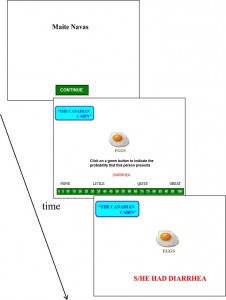What Do We Pay Attention To? The Importance of Cues and Context in Predictive Learning
As humans, we choose to pay attention to certain things and deem others irrelevant. A growing body of research focuses on various measures of stimulus processing to better characterize changes in attention that occur during human predictive learning. The study conducted by Aristizabal et al. (2016) used eye-fixation tests on a computer screen to investigate how humans choose to pay attention to certain contexts/cues, and how this changes over time. Prior research has supported that attention to irrelevant contexts should be high initially, and then decrease as training progresses. The experimenters predicted that eye fixations to contexts would decrease as the participants went through more trials, and that patients would discard contexts as potential predictors of outcomes. Alternatively, they predicted that eye-fixations to cues would increase and remain high once participants learned that paying attention to the cues rather than the contexts was essential to predict outcomes.
In this particular study, the experiment was designed to take an independent measure of the attention context and cues received during training, which in this case was eye-gazing behavior. The cues in this study were particular foods, the contexts were particular restaurants, and the outcomes were presence or no presence of diarrhea. Participants in this study were presented with tasks on a computer screen that also had eye-recording software to monitor eye gazing. A stimulus screen was then presented to the participant that contained the stimulus/cue (ie. egg or garlic), context restaurant (The Swiss Cow or The Canadian Cabin), and the choice of choosing the probability that the person showed diarrhea (Figure 1). Following the stimulus screen, a feedback screen was shown to the participant that had the outcome (she had or did not have diarrhea). This process was considered one trial. The outcome did not depend on which response the participant gave. All participants received 48 trials with each cue in each context.
Fig. 1.
Example of a trial including the Loading screen (top) the Stimulus screen (middle) and the Feedback screen (bottom). In this example the cue was followed by the outcome. The scale contents of the screens have been adapted to facilitate reading, and they have been translated to English (Aristizabal et al., 2016).
The main goal of this study was to observe the pattern of the attention drawn by cues and contexts along repetitive training in a human predictive learning situation. As predicted by the experimenters, eye-fixations to the cues (food) increased while eye-fixations to the contexts (restaurants) decreased as training and trials increased. These results have implications that go further than this particular study. This experiment provided further support that attention to irrelevant contexts decrease in response to increased exposures and humans learn to discard this extra “noise” as potential predictors of outcomes. Ecologically, this could mean that humans and other species learn to visually inhibit some and process other types of stimuli that can lead to certain behavior. Predictive cues accrued more visual attention than non-predictive cues. These mechanisms could be evolutionarily beneficial to organisms. Humans and other species may learn over time to better respond to predators or dangerous situations because they know how to filter out the irrelevant information that won’t help outcomes.
https://commons.wikimedia.org/wiki/File:Jean_Balukas_NYWTS.jpg
This study also pointed out that attention to irrelevant cues did not decline over repeated training, while attention to irrelevant contexts did. In other words, attention to cues increased over training, regardless of whether those cues were followed by the presence or absence of the outcome. The point was that the participants learned over time that the cue was helpful in predicting the outcome, not the context. However, the experimenters certainly did not imply that only cues are paid attention to while contexts are always considered irrelevant in every situation. Many cues and contexts can be interchangeable and some contexts may be predictive of certain outcomes. The point of this study was that humans have mechanisms by which they can filter out irrelevant information that do not help predict outcomes, whether it is certain cues or environments that they are in.
This study may help set a good foundation for future research into selective information processing. While this study only monitored the visual system and eye movements, it may be helpful to study other sensory processes such as touch, taste, and hearing. All of these senses are critical in predicting outcomes and responding with appropriate behavior, and it would be interesting to observe if humans have similar strategies of picking what types of information to focus on in these other systems. It would also be insightful to study the physiological mechanisms by which this phenomenon occurs. The experimenters mentioned that humans initially pay attention to as many cues and contexts as they can, both relevant and irrelevant. It is only over time and with repeated exposures that humans learn to selectively weed out the important information, so it would be interesting to know what neural processes modulate this phenomenon. The amygdala in particular is known to be involved in fear learning that associates certain stimuli with aversive outcomes. Studying various parts of the amygdala may help us understand how we decide to pay attention to certain cues over others, create associations with outcomes, and how these mechanisms can shape beneficial behavior such as avoiding foods that may cause digestive problems, fight or flight, and escaping danger in response to predation.
Source: Aristizabal, J.A., Ramos-Alvarez, M.M.R., Callejas-Aguilera, J.E., and Rosas, J.M. (2016). Attention to irrelevant contexts decreases as training increases: Evidence from eye-fixations in a human predictive learning task. Behavioral Processes, 124, 66-73.


